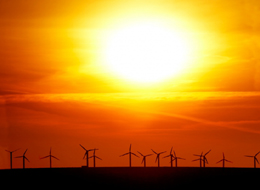Home > Press > CAS Launches Photovoltaic Research Initiative
 |
Abstract:
The Chinese Academy of Sciences (CAS) has launched an initiative to boost the development of solar energy technology, in a bid to turn it into a major energy source in China by 2050. The initiative, which was approved by CAS's CCP committee on Dec. 23rd, 2008, was made public on the annual meeting of CAS officials in late January.
CAS Launches Photovoltaic Research Initiative
Beijing, China | Posted on February 2nd, 2009 CAS had started to motivate its experts to make an action plan and to set up a platform to support the research in solar energy utilization. It aims to forge complete value chain including basic research, application research and market research.
The plan will be carried out in three phases, including "utilization in selective areas" by 2015, "utilization as an alternative energy" by 2025 and "large-scale utilization" by 2035, respectively.
CAS experts said that China has a large potential for solar energy development. The duration of sunshine for two-thirds of its territory is more than 2,200 hours a year. It also has vast desert areas, where solar energy could be "harvested". According to an energy industry survey by CAS experts, China has made enormous progress in photovoltaic sector. However, the research centers are scattered and lack of cutting-edge technology.
The United States, Japan and European countries began to develop solar energy in the 1970s. Government investment has greatly promoted solar energy research and development, especially in Japan, Germany and Australia.
Germany has been promoting a so-called "Solar Energy Family Program", and fixed solar energy facilities on the roofs of homes. Japan has launched a program to accelerate the use of solar energy, and to cut the price of solar energy by half within three to five years.
Experts said that lowering the costs for using solar energy is the key for stepping up the use of this renewable energy in China.
####
About Chinese Academy of Sciences (CAS)
CAS strives to build itself into a scientific research base at advanced international level, a base for fostering and bringing up advanced S&T talents, and a base for promoting the development of China's high and new technology industries. By 2010, CAS will have about 80 national institutes noted for their powerful capacities in S&T innovation and sustainable development or with distinctive features; thirty of them will become internationally acknowledged, high-level research institutions, and three to five will be world class.
For more information, please click here
Contacts:
Chinese Academy of Sciences
Add: 52 Sanlihe Rd., Beijing China
Postcode: 100864
Tel: 86 10 68597289
Fax: 86 10 68512458
Chief-Editor's Information:
Guo Haiyan
the Editor
Bulletin of Chinese Academy of Sciences
CAS Institute of Policy & Management,
P.O.Box 8712, Beijing 100080, China.
Copyright © Chinese Academy of Sciences
If you have a comment, please Contact us.Issuers of news releases, not 7th Wave, Inc. or Nanotechnology Now, are solely responsible for the accuracy of the content.
| Related News Press |
News and information
![]() Researchers develop molecular qubits that communicate at telecom frequencies October 3rd, 2025
Researchers develop molecular qubits that communicate at telecom frequencies October 3rd, 2025
![]() Next-generation quantum communication October 3rd, 2025
Next-generation quantum communication October 3rd, 2025
![]() "Nanoreactor" cage uses visible light for catalytic and ultra-selective cross-cycloadditions October 3rd, 2025
"Nanoreactor" cage uses visible light for catalytic and ultra-selective cross-cycloadditions October 3rd, 2025
Govt.-Legislation/Regulation/Funding/Policy
![]() New imaging approach transforms study of bacterial biofilms August 8th, 2025
New imaging approach transforms study of bacterial biofilms August 8th, 2025
![]() Electrifying results shed light on graphene foam as a potential material for lab grown cartilage June 6th, 2025
Electrifying results shed light on graphene foam as a potential material for lab grown cartilage June 6th, 2025
![]() Institute for Nanoscience hosts annual proposal planning meeting May 16th, 2025
Institute for Nanoscience hosts annual proposal planning meeting May 16th, 2025
Announcements
![]() Rice membrane extracts lithium from brines with greater speed, less waste October 3rd, 2025
Rice membrane extracts lithium from brines with greater speed, less waste October 3rd, 2025
![]() Researchers develop molecular qubits that communicate at telecom frequencies October 3rd, 2025
Researchers develop molecular qubits that communicate at telecom frequencies October 3rd, 2025
![]() Next-generation quantum communication October 3rd, 2025
Next-generation quantum communication October 3rd, 2025
![]() "Nanoreactor" cage uses visible light for catalytic and ultra-selective cross-cycloadditions October 3rd, 2025
"Nanoreactor" cage uses visible light for catalytic and ultra-selective cross-cycloadditions October 3rd, 2025
Energy
![]() Sensors innovations for smart lithium-based batteries: advancements, opportunities, and potential challenges August 8th, 2025
Sensors innovations for smart lithium-based batteries: advancements, opportunities, and potential challenges August 8th, 2025
![]() Simple algorithm paired with standard imaging tool could predict failure in lithium metal batteries August 8th, 2025
Simple algorithm paired with standard imaging tool could predict failure in lithium metal batteries August 8th, 2025
Solar/Photovoltaic
![]() Spinel-type sulfide semiconductors to operate the next-generation LEDs and solar cells For solar-cell absorbers and green-LED source October 3rd, 2025
Spinel-type sulfide semiconductors to operate the next-generation LEDs and solar cells For solar-cell absorbers and green-LED source October 3rd, 2025
![]() KAIST researchers introduce new and improved, next-generation perovskite solar cell November 8th, 2024
KAIST researchers introduce new and improved, next-generation perovskite solar cell November 8th, 2024
![]() Groundbreaking precision in single-molecule optoelectronics August 16th, 2024
Groundbreaking precision in single-molecule optoelectronics August 16th, 2024
![]() Development of zinc oxide nanopagoda array photoelectrode: photoelectrochemical water-splitting hydrogen production January 12th, 2024
Development of zinc oxide nanopagoda array photoelectrode: photoelectrochemical water-splitting hydrogen production January 12th, 2024
|
|
||
|
|
||
| The latest news from around the world, FREE | ||
|
|
||
|
|
||
| Premium Products | ||
|
|
||
|
Only the news you want to read!
Learn More |
||
|
|
||
|
Full-service, expert consulting
Learn More |
||
|
|
||








